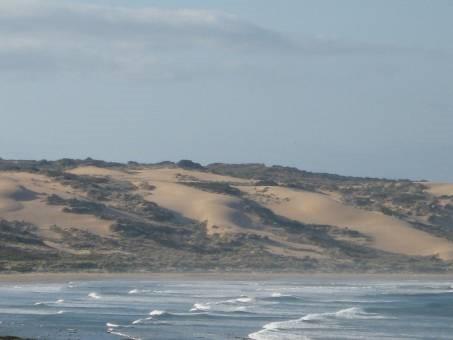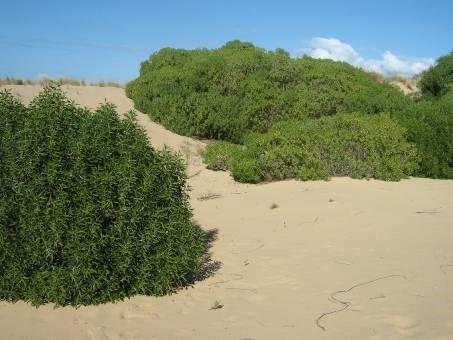Video
MOSSELBAAI NUUS - Coastal alien vegetation is detrimentally affecting the health and biodiversity of our coastal ecosystems.
There are three most detrimental species which are currently or have taken over the southern coast of Africa: the infamous Rooikrans Acacia cyclops, and two other species which deserve much more publicity than they have received to date, namely Marram Grass Ammophila arenaria and Manatoka Myoporum tenuifolium subs. montanum. In Fransmanshoek Conservancy, 18km of coastline just west of Mossel Bay, we are experiencing the brunt of all three.
Rooikrans is a tree originally from Australia, brought to Cape Town as an ornamental in the 1800s, and later used for dune stabilisation on the Cape Flats. It is a tree reaching 5m with woody stems, tapered narrow supple green 1cm x 8cm leaves with a rounded point and three mid-veins, 1cm round yellow flowers and 10cm long curved seed pods. The seeds are dispersed by birds (long distance) and ants (short distance) and are able to lie dormant in sand for 40 years.
The detrimental effects on nature are that this species uses large amounts of water compared to fynbos, creates a canopy impenetrable by sunlight over natural vegetation leading to the death of the natural vegetation, stabilises dunes, out-competes natural vegetation and contributes to a loss in biodiversity. It makes nitrates available to the soil which our natural vegetation cannot tolerate and creates a serious fire hazard due to a massive fuel load and highly flammable oils. Due to the highly flammable oils found in living trees, they are just as flammable as a dead Rooikrans.
Rooikrans has been placed by CARA (The Conservation of Agricultural Resources Act, species list 2016) in Category 1b, which simply put, means that it is a prohibited species, but individuals already present may be left alive if control measures are in place.
The methods through which it can be controlled are mechanical, chemical or biological. For mechanical control the tree may be felled or seedlings under 65cm may be pulled by hand. For felling, the stumps do not need herbicide application if the bark has already burst, but younger individuals may resprout if conditions are favourable. Chemical control may be utilised in the form of applying herbicide for foliar spraying or basal stump application.
Biological agents are also currently playing a role. The seed weevil, Melanterius servulas I, was introduced from Australia in the 90s but only has a 5% reduction in seeds.
The gall forming midge Dasineura dielsi was introduced after the millennium and has a very successful effect in reducing the seed production by 95%. The midge taints the flower at an early age resulting in the formation of a fertile 1.5cm twisted ball of deformed seeds instead of pods.
There is also an indigenous root fungus at work. The root fungus, first noted at Great Brak River, attacks the roots of the tree, eventually leading to its death. The fungus thrives in hot weather when the elements converge to provide the right conditions, killing off patches of Rooikrans in dense stands or individual trees in mixed stands of alien and indigenous vegetation.
A positive spin-off of Rooikrans is that it is one of the best braai woods in South Africa with a large number of jobs and livelihoods being created for the thousands of Rooikrans cutters in our country.
Manatoka
Next on the list is Manatoka which many people still believe is an indigenous tree and is therefore widely used in urban gardens and beyond. This misidentification is a problem. The tree was introduced from Australia as an ornamental or shade plant. It is a tree also reaching 5m, with supple stems and a milky white latex (sap), 2cm x 11cm tapered supple green leaves with a well-defined mid-vein, 1cm white flowers and 5mm red berries.
The seeds are dispersed by birds. The tree also makes use of vegetative reproduction, where root runners radiate from mature trees just below the soil surface and shoots appear a distance away. Young trees very often pop up where Rooikrans has been removed. The reason for this is that the seeds are brought in by birds that perch on the Rooikrans. Once the Rooikrans has been removed sunlight activates the Manatoka seeds (as well as multitudes of Rooikrans seeds). Manatoka seedlings then appear in numbers. This must be watched out for as a stand of Manatoka is much worse than a stand of Rooikrans.
 If this photo of the Misgunst dunes was taken 40 years ago there would be no vegetation visible. All of the vegetation is alien.
If this photo of the Misgunst dunes was taken 40 years ago there would be no vegetation visible. All of the vegetation is alien.
The detrimental effects which Manatoka has on the ecosystem are much the same as Rooikrans except that it does not present a fire hazard and it does not make nitrates available to the soil. It is, however, poisonous to mammals.
Manatoka has been placed by CARA in Category 3 which simply put means that it may no longer be planted. The methods through which it can be controlled are mechanical or chemical. Unfortunately, a biocontrol agent has not been introduced. For mechanical control the tree may be felled with cut stump herbicide application, as the tree is a vigorous resprouter or seedlings under 1m may be hand pulled. For chemical control herbicide may be administered once again by foliar spraying or basal stump application. Many people wonder why the planting of alien trees in residential areas is so bad for the environment. After all, it is no longer a natural ecosystem, but a man-made garden?
The answer to that is that the seeds of these plants are not restricted to this garden, but are dispersed over many kms, by birds and other vectors, infecting natural areas. Instead of planting alien vegetation why not try some of the indigenous coastal trees of our region such as White Milkwood, Wild Olive, Camphor or some of the larger Rhus species. These will also attract indigenous fauna back into your garden.
 A 5m mature Manatoka and some of its root shoots. Photos: Wayne Meyer
A 5m mature Manatoka and some of its root shoots. Photos: Wayne Meyer
Marram Grass
In the 1980s the Department of Agriculture ordered all landowners of dune systems to plant the grass in an effort to stabilise the sands. This was accomplished in many areas, but with devastating consequences on the dune system ecosystems. The grass has now spread to all areas along our coast.
Marram grass has no other uses or positive spin-offs. The grass reaches an average height of 1m, is straw-like when dry, with wheat-like seeds and an extensive system of underground roots and rhizomes up to 2m deep. The seeds are dispersed by wind and water as well as the plant making use of vegetative root reproduction as with Manatoka. The detrimental effects which Marram grass has on the ecosystem are dune stabilisation, using large amounts of water and contributing to a loss of biodiversity.
 A stand of 30-year-old mature 5m Rooikrans trees.
A stand of 30-year-old mature 5m Rooikrans trees.
As with the other two species, once the plant is killed, the damage can't be reversed as the sands will be stabilised for years to come while the roots slowly decompose. Also, once any of these three species appear on an open dune of sand they provide shelter and traps in which other seeds can propagate and grow. Even if these seeds which propagate into plants are of indigenous origin, it does not mean that they are meant to be there. Mobile sand dunes and frontal sand dune systems are not meant to be vegetated, besides a few scattered hardy indigenous species. Marram Grass is listed on CARA in Category 3. The only control method is chemical, by foliar spraying with herbicide.















